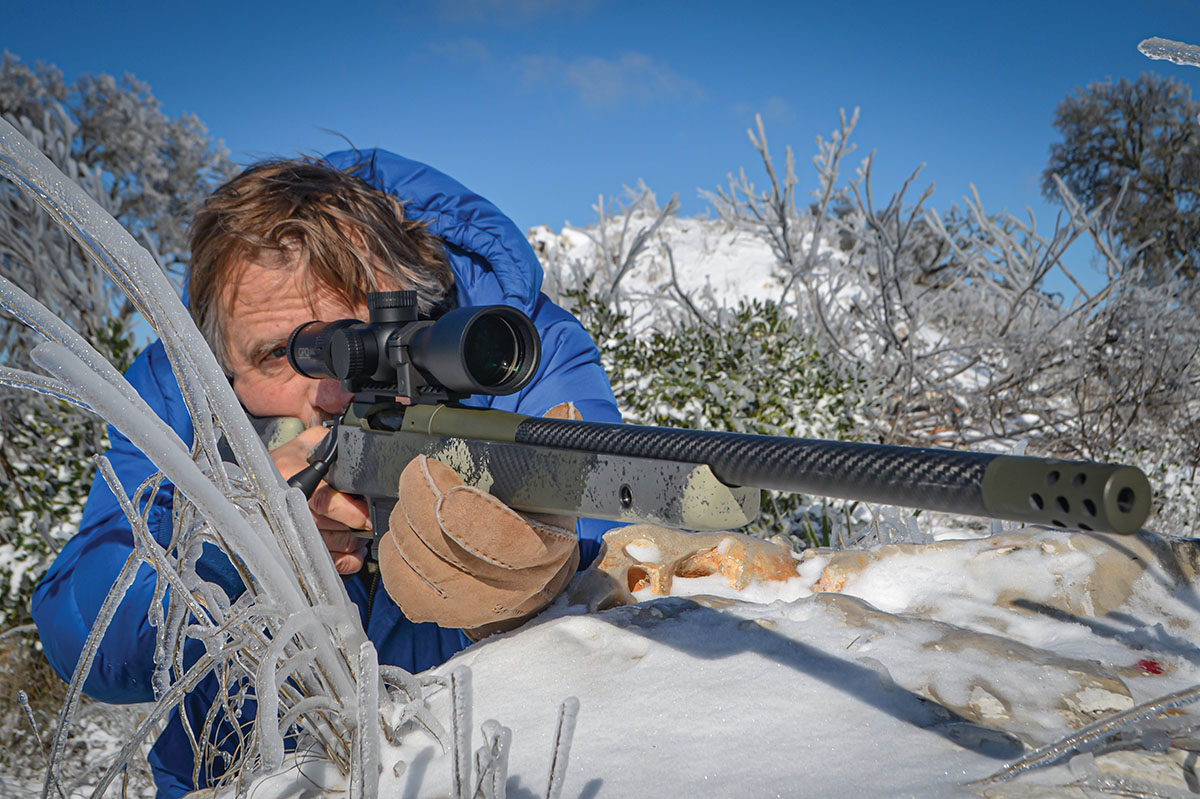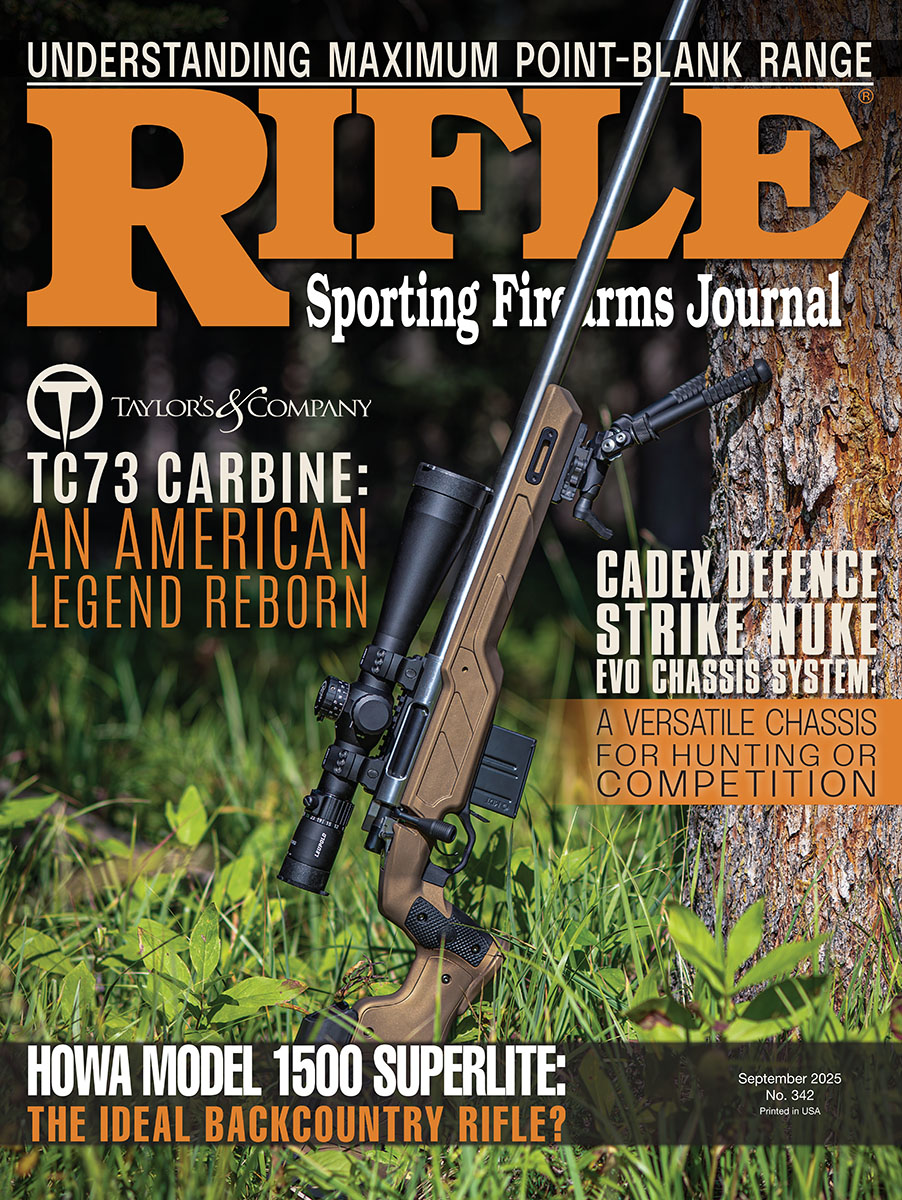Walnut Hill
Point Blank
column By: Terry Wieland | September, 25

This, thought I, required some explaining. So, contrary to my usual custom, I clicked on the button to see what was up.
The revelation came from Charlie Jacoby, who is involved with Fieldsports Britain on the Fieldsports channel. I met Charlie about ten years ago, in Germany, when we were shooting driven boar and such, and found him to be both highly knowledgeable about rifles and a very nice guy. I mention this to show that I have no predisposition to discount what he tells me.
Anyway, it turns out that he was about to be instructed by two Royal Marine snipers on a revolutionary (to him, apparently) new approach to sighting in your hunting rifle. Instead of doing the British usual, zeroing it an inch high at 100 meters, they were going to employ the latest technology to produce a zero whereby the shooter will neither need to memorize trajectory numbers nor get an accurate measurement of distance. All you do is learn what a maximum range looks like and hold dead on for anything out to there.
If that sounds familiar, it should: it’s a method called Maximum Point-Blank Range (MPBR) and dates back to the early 1980s, and probably before. I first read about it in a piece by Jim Carmichel and have used the approach on all my hunting rifles since 1985. I asked Jim about it at one point, and he told me that while he may have popularized it in his column or one of his books, he did not invent it and could not remember where he first learned about it.
Most readers are probably already familiar with MPBR, but for those who may not be, it works like this.
As we all (I fervently hope) know, a rifle bullet leaves the muzzle, rises through the line of sight to a maximum height, falls back through the line of sight due to gravity, and eventually hits the ground. It rises because the muzzle is slightly elevated to combat gravity, and it falls at an ever-accelerating rate as it loses velocity. We could go further into the arcane aspects of exterior ballistics, but that should do for now.
Years ago, it was the practice to zero a rifle at 100 yards. You then made a note of how much the bullet dropped at 150, 200 and so on. When you spotted an animal, you estimated the range, tried to remember how much the bullet would drop and then held that high. As you can see, there are a lot of ifs and variables in there, and the potential for error is substantial.
You could sight your rifle for, say, 300 yards, in an attempt to eliminate one of the variables, but that could mean the bullet’s mid-range trajectory, its highest point above the line of sight, could be so great that you risk shooting over your target closer in.
Some brilliant soul thought this through and came up with the solution: Figure the size of the kill zone in an animal (eight inches for an elk, for example) and sight your rifle for a distance that allowed the bullet to rise no more than half that (four inches) at mid-range. Let’s say that would put your actual zero at 267 yards. You then figured how much farther on the bullet would fall four inches below, and that became your MPBR.
When you venture forth to hunt elk, all you have to be able to recognize is any distance beyond your maximum. For example, your rifle might be zeroed for 267 yards and have an MPBR of 326. Therefore, all you had to know was when an animal was more than 326 yards away. Anything inside that distance, you held dead on, knowing your bullet would be in the kill zone.
Another way to look at this: You could hang an eight-inch diameter steel plate anywhere out to that maximum distance, hold dead on, and hit it. It might be high, low, or near the center, but you’d hit the kill zone.
In those days, before personal chronographs and digital rangefinders, we had to depend on printed trajectory tables and factory velocity claims, all of which made it a little tricky. There was also the problem of situating a target at precisely 267 yards for sighting in, but we got around that by figuring out how high the bullet would be at 100 yards, then sighting it in for that on a standard shooting range.
Naturally, anyone who took all this at face value and went off to Alaska to hunt mountain sheep without checking his sighting every which way was an idiot, but that’s as true now as it was then.
A lot has changed in the last 40 years, most of it for the better when it comes to optics and, right away, I should acknowledge the fact that with the rise of sniper techniques and technology, the 100-yard zero has once again come to the fore. With modern all-adjustable riflescopes, the advantage of a digital rangefinder, and precise knowledge of your bullet’s velocity, ballistic coefficient and trajectory, the practice is to dial the scope up or down from your basic 100-yard zero.
This is great if you are (a) a sniper and part of a highly trained team; (b), a long-range competitor shooting at measured distances from a solid bench, or (c), in a hunting stand with a solid rest, waiting for an animal to appear on a far hillside where you can measure the distance to the inch.
It’s not so great if you are on foot and moving around, hoping to spot an animal. Still-hunting in brush country, for example, you can come on an animal at anything from ten feet to 200 yards and often must be prepared to shoot quickly or not at all. This is my kind of hunting, and I want my rifle sighted in accordingly. It’s where MPBR works to perfection.
The Royal Marine sniper, who was instructing Charlie Jacoby, had the use of a Garmin chronograph to measure velocity precisely, as well as a Kestrel ballistic computer to aid with elevation, atmospheric density and all the other factors we either ignored or knew little about in the 1980s. And frankly, those are not huge concerns when you are expecting to shoot inside, say, 350 yards.
Today, there are programs available on the internet that will give you your bullet’s trajectory to a gnat’s whisker, so you don’t have to depend on printed trajectory tables that, in turn, depend on rounded velocity numbers – 2,700 feet per second (fps), 2,800 fps and so on – and BC numbers (.350, .400) when your average velocity is somewhere in between and your BC is measured in fractions. I generally use Hornady’s ballistic calculator, but there are several others.
My first reaction when I received the email was “How can they not already know this?” But then it struck me that when I was reading about MPBR back in the 1980s, many of today’s shooters were not even born. Rifle and scope manufacturers are interested in pushing the latest technology, and instruction camps like the FTW Ranch and Gunsite Academy largely teach sophisticated sniper techniques.
Also, there was no internet way back then, but that is, at best, a mixed blessing. We may flatter ourselves that online we have all human knowledge at our fingertips, but it’s like a huge library with none of the books labeled. And anyway, who do you believe?
The funny thing is that throughout the history of firearms, techniques are developed, lost, forgotten, rediscovered and presented as new. This is just one more instance, but it does make one feel old.


